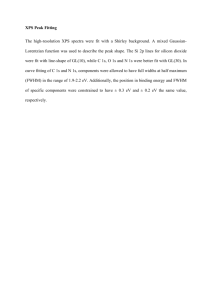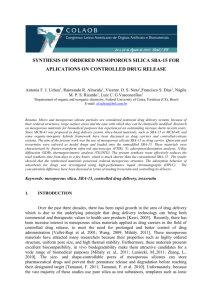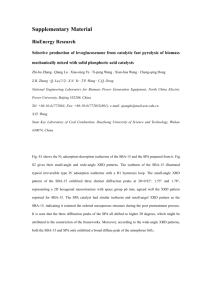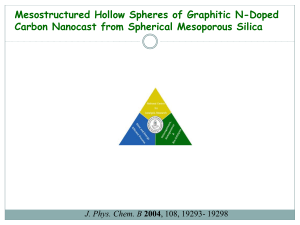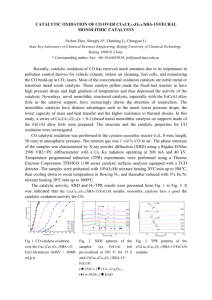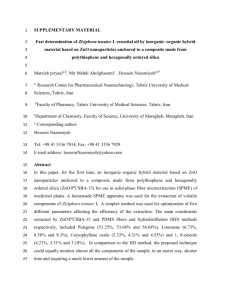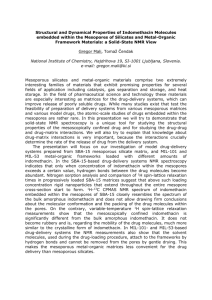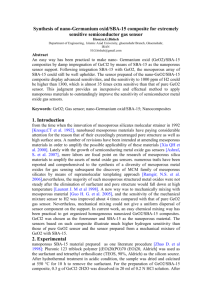Microsoft Word
advertisement
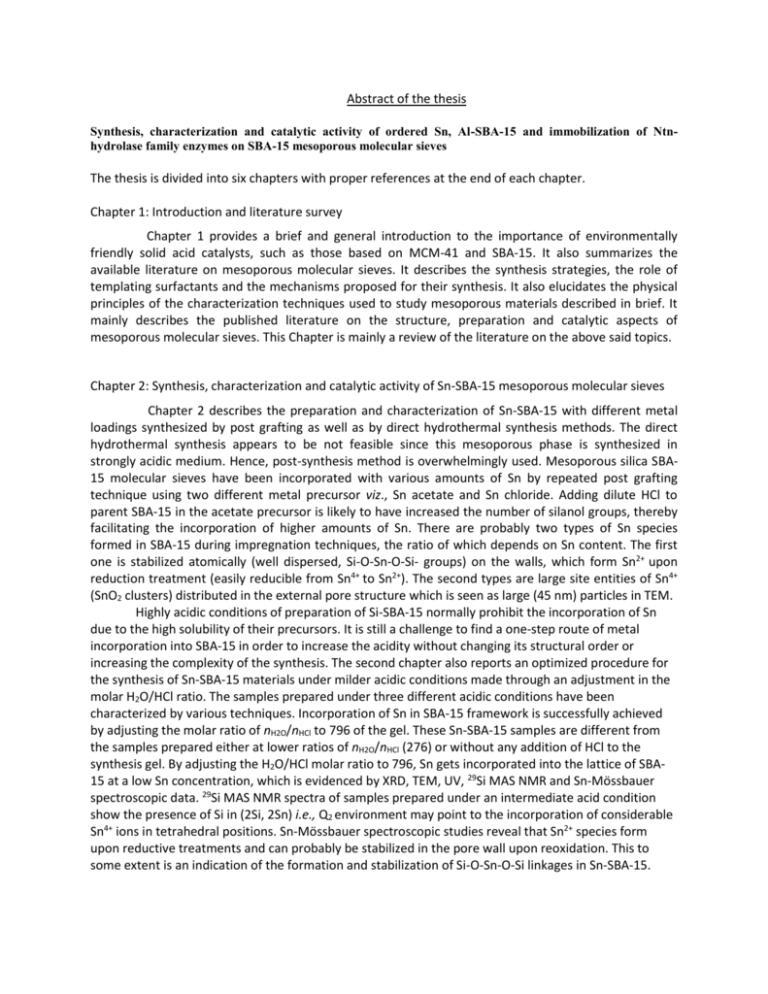
Abstract of the thesis Synthesis, characterization and catalytic activity of ordered Sn, Al-SBA-15 and immobilization of Ntnhydrolase family enzymes on SBA-15 mesoporous molecular sieves The thesis is divided into six chapters with proper references at the end of each chapter. Chapter 1: Introduction and literature survey Chapter 1 provides a brief and general introduction to the importance of environmentally friendly solid acid catalysts, such as those based on MCM-41 and SBA-15. It also summarizes the available literature on mesoporous molecular sieves. It describes the synthesis strategies, the role of templating surfactants and the mechanisms proposed for their synthesis. It also elucidates the physical principles of the characterization techniques used to study mesoporous materials described in brief. It mainly describes the published literature on the structure, preparation and catalytic aspects of mesoporous molecular sieves. This Chapter is mainly a review of the literature on the above said topics. Chapter 2: Synthesis, characterization and catalytic activity of Sn-SBA-15 mesoporous molecular sieves Chapter 2 describes the preparation and characterization of Sn-SBA-15 with different metal loadings synthesized by post grafting as well as by direct hydrothermal synthesis methods. The direct hydrothermal synthesis appears to be not feasible since this mesoporous phase is synthesized in strongly acidic medium. Hence, post-synthesis method is overwhelmingly used. Mesoporous silica SBA15 molecular sieves have been incorporated with various amounts of Sn by repeated post grafting technique using two different metal precursor viz., Sn acetate and Sn chloride. Adding dilute HCl to parent SBA-15 in the acetate precursor is likely to have increased the number of silanol groups, thereby facilitating the incorporation of higher amounts of Sn. There are probably two types of Sn species formed in SBA-15 during impregnation techniques, the ratio of which depends on Sn content. The first one is stabilized atomically (well dispersed, Si-O-Sn-O-Si- groups) on the walls, which form Sn2+ upon reduction treatment (easily reducible from Sn4+ to Sn2+). The second types are large site entities of Sn4+ (SnO2 clusters) distributed in the external pore structure which is seen as large (45 nm) particles in TEM. Highly acidic conditions of preparation of Si-SBA-15 normally prohibit the incorporation of Sn due to the high solubility of their precursors. It is still a challenge to find a one-step route of metal incorporation into SBA-15 in order to increase the acidity without changing its structural order or increasing the complexity of the synthesis. The second chapter also reports an optimized procedure for the synthesis of Sn-SBA-15 materials under milder acidic conditions made through an adjustment in the molar H2O/HCl ratio. The samples prepared under three different acidic conditions have been characterized by various techniques. Incorporation of Sn in SBA-15 framework is successfully achieved by adjusting the molar ratio of nH2O/nHCl to 796 of the gel. These Sn-SBA-15 samples are different from the samples prepared either at lower ratios of nH2O/nHCl (276) or without any addition of HCl to the synthesis gel. By adjusting the H2O/HCl molar ratio to 796, Sn gets incorporated into the lattice of SBA15 at a low Sn concentration, which is evidenced by XRD, TEM, UV, 29Si MAS NMR and Sn-Mössbauer spectroscopic data. 29Si MAS NMR spectra of samples prepared under an intermediate acid condition show the presence of Si in (2Si, 2Sn) i.e., Q2 environment may point to the incorporation of considerable Sn4+ ions in tetrahedral positions. Sn-Mössbauer spectroscopic studies reveal that Sn2+ species form upon reductive treatments and can probably be stabilized in the pore wall upon reoxidation. This to some extent is an indication of the formation and stabilization of Si-O-Sn-O-Si linkages in Sn-SBA-15. The studies reveal that the method of preparation, nH2O/nHCl ratio and the nSi/nSn ratio (concentration of SnCl4) of the gel significantly influence the type of tin species in the resulting Sn-SBA15 samples. In the present study, we have examined the catalytic properties of these Sn-SBA-15 samples in three industrially important reactions, viz., trans-esterification of diethyl malonate, synthesis of nopol by Prins condensation of β-pinene with para-formaldehyde and the epoxidation of norbornene. In each of this reaction, while demonstrating the catalytic role of Sn species, we show that requirement of the type and the environment of Sn species is different for these reactions. The effect of various reaction parameters such as Si/Sn ratio, amount of the catalyst, temperature and reaction time on the influence of reaction is also studied. Sn-B-40 is more efficient for Prins condensation and epoxidation reaction than Sn-A-40, Sn-C-40 and other Sn impregnated samples. In other words, support influences the catalytic activity. The activities of Sn-B-40 catalysts are lower for transesterification of diethylmalonate. The structure of the catalyst, amount and type of acidity and the method of preparation influenced the catalytic activity. Chapter 3: Synthesis, characterization and catalytic activity of mesoporous Al-SBA-15 molecular sieves Chapter 3 describes the synthesis and characterization of Al-SBA-15 by post grafting as well as by direct hydrothermal synthesis method. Physico-chemical characterization was done by various spectroscopic methods to understand the chemical nature of incorporated Al. In case of impregnated samples, the presence of silanol OH group of the wall of SBA-15 sample is being used up to react with Al precursors to form Si-O-Al-O linkages, which ultimately develop into thin films on the walls of SBA-15. Highly acidic conditions of preparation of SBA-15 normally prohibit the incorporation of Al due to the high solubility of their precursors. We report here an optimized procedure for the synthesis of Al-SBA-15 under milder acidic conditions were made through an adjusting the molar H2O/HCl ratio which indicate the formation of Si-O-Al linkages that lead to isomorphous substitution of Si4+ by some Al3+ ions. By adjusting the H2O/HCl molar ratio, Al gets incorporated into the lattice of SBA-15, which is evidenced by XRD, TEM, 29Si and 27Al MAS NMR spectroscopic data. Aluminium incorporated SBA-15 samples retained both structural and textural properties of SBA-15. The 27Al MAS NMR confirms that a large proportion of the Al is inserted into tetrahedral positions within the framework. The Al3+ ions could assume a tetrahedral coordination and be part of the hexagonal structure of silica in Al-SBA-15. In the present study, we have examined the effectiveness of Al-SBA-15, as an acid catalyst for the esterification reaction and in benzylation of anisole. The effect of various reaction parameters such as Si/Al ratio, amount of the catalyst, temperature and reaction time on the influence the reaction is also studied. The high activity of Al-20 sample in esterification reaction has been attributed to isolated, generally tetrahedrally coordinated, framework Al species. Larger Al2O3 particles are known to inhibit esterification reactions by decreasing the number of accessible catalytic sites. While in benzylation of anisole, the best result was achieved with Al-5 catalyst, which has a larger number of acid sites. The Al content increases the conversion and also yield due to an increase in the number of active centers. The selectivity for benzylanisole increases and that for dibenzylether decreases with increase in the Si/Al ratio of Al-SBA-15. Chapter 4: Non ambient powder X-ray diffraction studies on mesoporous SBA-15, Sn-SBA-15 and Al-SBA15 molecular sieves Chapter 4 includes two parts which describes the thermal stability of SBA-15, Sn-SBA-15 and AlSBA-15 material and the effect of isomorphous substitution of Sn and Al on the thermal expansion behavior investigated by in-situ HTXRD analysis for the first time in literature. The study of structural and spectral aspects of a material is of great importance to understand its chemistry. As there is no study reported on the thermal expansion behavior of SBA-15 in literature, we have made an attempt to study the structural changes that occur in SBA-15, Sn and Al-SBA-15 as a function of temperature by in-situ HTXRD studies. The Chapter includes two parts. Part-1: HTXRD studies of SBA-15 and Sn-SBA-15 samples Part I describes the in-situ HTXRD studies in the temperature range 298-1573 K carried out on SBA-15 and Sn-SBA-15 mesoporous molecular sieves (with Si/Sn=80, 60, 40 and 10) prepared through direct synthesis route. SBA-15 is found to be thermally highly stable upto 1473 K and appearance of αcristobalite was observed at 1573 K also supported by the thermogravimetric (TG) data. A strong negative thermal expansion was observed on heating from 298 to 1573 K (αa=-4.3 x 10-6 K-1). Sn containing samples (Si/Sn = 80 and 60) showed a positive thermal expansion (6.745 x 10 -6 K-1 and 9.944 x 10-6 K-1 respectively). On the other hand, the samples with Si/Sn = 40 and 10 having higher Sn content, showed a strong negative thermal expansion (-4.12 x 10-6 K-1 and -7.64x 10-6 K-1) similar to SBA-15. The linear thermal expansion coefficient varied in the order: Si/Sn= 60 > 80 > 40 > 0 > 10. This variation in αa with Sn concentration is due to the presence of higher concentration of Sn4+ ions in the SBA-15 lattice framework in Sn-60 and Sn-80 as compared to Sn-40 and Sn-10 samples. Sn4+ ions exhibit both tetrahedral and octahedral coordination depending upon the location of these ions either on the walls of the silica (in samples with Si/Sn = 80 and 60) or in the corona region of the structure (in samples with Si/Sn = 40 and 10) respectively. Part-2: HTXRD studies of Al-SBA-15 samples Part II describes the in-situ HTXRD studies in the temperature range 298-1573 K carried out on Al-SBA-15 mesoporous molecular sieves (with Si/Al = 80, 60, 40, 20, 10 and 5) prepared through direct synthesis route. Al-SBA-15 sample shows the positive linear thermal expansion coefficient for Al-80 sample and negative for Al-60 and Al-40 samples from 298-1473 K. On cooling the sample from 1473 K to RT, the only positive thermal expansion coefficient was observed and the values are 5.59x10-6 K-1, 10.02x10-6 K-1 and 16.01x10-6 K-1 for Al-80, Al-60 and Al-40 samples respectively. The magnitude of the coefficient of thermal expansion increases in this order, Al-80 > Al-60 > Al-40. For high Al containing samples (Al-20, Al-10 and Al-5), the linear thermal expansion coefficient is negative both during heating in the temperature range 298-1473 K and on cooling from 1473-373 K. On cooling, the values of the linear thermal expansion coefficient from 1473-373 K are –19.84 x10-6 K-1 and –27.33x10-6 K-1 and – 47.48x10-6 K-1 for Al-20, Al-10 and Al-5 samples respectively. The very strong NTE coefficients observed for these samples is likely due to the transverse vibration of the bridging oxygen in two-fold coordination between two polyhedrons causing a shortening of Si–Si non-bonding distance. The magnitude of the coefficient of thermal expansion increases in this order, Al-20 > Al-10 > Al-5. There is a recognizable correlation between the Si/Al ratio and the thermal expansion behavior of the material which is dependent on the concentration of Al. The thermal decomposition of the samples (TG data) is correlated to the thermal expansion behavior (HTXRD data). TG-DTA data reveal a shift in the decomposition temperature of template to higher value with increasing Sn or Al concentration. This indicates that the template ions located within the pores is strongly influenced by the presence of metal ions (Sn or Al) in the framework and a ‘soft’ interaction probably exists between the template ions and the Sn or Al sites. Chapter 5: Structural features of immobilized Penicillin G acylase and Bile salt hydrolase adsorption on APTES functionalized SBA-15 Chapter 5 describes the immobilization of Ntn hydrolase family enzymes e.g., Penicillin G acylase (PGA) and Bile salt hydrolase (BSH) on APTES functionalized SBA-15. This chapter is also divided into two parts: Part-1: Immobilization of Penicillin G acylase enzyme Part 1 describes the effect of the immobilization of PGA on the amino (APTES)-functionalized SBA-15 materials and the effect of silica as host matrix on enzyme kinetics. Physico chemical characterization was done by nitrogen adsorption, powder XRD and TEM methods to understand the nature of immobilized PGA enzyme. XRD and nitrogen adsorption data reveals that these samples retain both structural and textural properties of mesoporous SBA-15. The maximum loading of the enzyme was observed at pH 7.8, slightly below the isoelectric point of the enzyme. The trapped enzyme is more stable than the soluble form, both to temperature and to pH environments and retained 73% of its activity after immobilization. This enhanced stability is attributed to the protective nature of the cage itself and to the rigidity of the SiO2 matrix, which reduces the freedom of peptide-chain refolding of molecular motions that occur in denaturation processes. It is important that the immobilized enzyme retains as much catalytic activity as possible after ten cycles of reusability. Part-2: Immobilization of Bile salt hydrolase enzyme Part 2 describes that the encapsulated BSH enzyme grafted through glutaraldehyde groups inside the channels of APTES functionalized SBA-15 imparts higher stability by the formation of covalent bonds with functionalized surface which effectively prevent the loss of activity. BSH is considered as an important enzyme which catalyzes the hydrolysis of glycine- and taurine-conjugated bile salts into amino acid residues and free bile acids. It reduces serum cholesterol level with its bile salt deconjugation property. Physico- chemical characterization was done by nitrogen adsorption, powder X-ray diffraction, TEM and 29Si CP-MAS NMR methods to understand the nature of immobilized BSH enzyme. The pH and temperature stability of Bile salt hydrolase (BSH) enzyme was also enhanced by the physical entrapment in SBA-15. The adsorption of BSH on SBA-15 from buffered solutions with different pH values has been studied as a model protein adsorption system. We examined the dry and wet storage of the BSH immobilized SBA-15 sample at room temperature over six months resulted in marginal loss of the initial activity, demonstrating their working stability in aqueous and low-water media. We have also carried out experiment to check the activity of immobilized enzyme towards co-precipitation of cholesterol. The experiment indicates that immobilized BSH enzyme may be the promising catalyst beneficial for bile deconjugation activity in vivo. Chapter 6: Summary and conclusions The Chapter 6 present a brief summary of the work described in previous chapters and general conclusions arrived from the work. Thus the thesis includes new investigations on different aspects such as synthesis procedures, synthesis mechanisms, heteroatom insertion, catalytic applications, thermal stability, physico-chemical characterization and enzyme immobilization.
